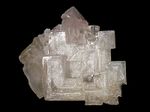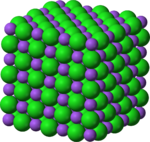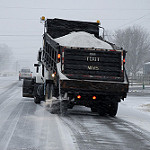Halite
Halite is the naturally occurring mineral form of the compound sodium chloride (NaCl), more commonly known as table salt. [1] Halite or salt, is a very important part of our every day lives. Almost every day, we use halite in one way or another. Some times we use it in foods, or to de-ice the roads, but those things only make up a small percent of salt usage. The chemical industry, farming, photography, water softeners, herbicides, medicines, and mouthwash are just a few places halite can be found. [2] Over all, halite is very useful and necessary to our daily lives.
Occurrences
Halite occurs in many different places. One place halite can be found is in sedimentary rocks. [3] A sedimentary rock is a rock that forms from materials being deposited in bodies of water or on the surface of the earth. These places can be called evaporite deposits. [4] Other places where halite can be found are in brine lakes, where halite crystallizes from the evaporated water, and ancient evaporated lakes. [5]
Another way halite is mined is from salt domes.[6] A salt dome is is a type of geological structure where a layer of salt shoots up into higher layers of soil and spreads out, forming a dome. Usually, salt domes do not reach the surface. When a salt dome reaches the surface, this is called a salt glacier. [7]
Structure
Halite, or sodium chloride, has a unique molecular structure called a crystal lattice. A crystal lattice is a type of three-dimensional molecular structure in which two oppositely charged molecules are closely arranged in a cubic model. [8] In halite, sodium is the negatively charged ion while chlorine is the positively charged ion.
Halite will take on many different shapes and colors. Besides the clear, cubic structure halite usually takes on, halite can be purple, red, pink, yellow, blue, orange, or gray. Halite can rarely be a halite flower, a curly form of halite. It will also form in small egg-like crystals. [1]
Uses
Halite has many different uses. Halite is most commonly known for being used as normal table salt.[9] It is mined, crushed packaged and shipped. It is also used in seasoning salts.[6] Another use for halite is managing ice.[1] In the winter, halite is crushed and spread on roads and highways to melt ice, helping drivers stay safe[9] Halite is also used in mineral waters, home water softeners, herbicides, fire extinguisher, mouthwash, and medicine. [2] Halite has many more uses, some of which may be unexpected, such as photography. [10]
Halite, or salt, is essential to our lives. Without it, we would die. Our nerves and cells can not function without salt.[11]
Even though it may seem like we use a lot of salt just for our food, we do not even come close to the other uses. Out of all the halite that is made into salt, forty percent of it is used in the chemical industry, another forty percent is used for de-icing the roads in the winter. The remaining twenty percent is used in other ways. Out of all the salt in the world, only one percent of it is used as table salt in the US.[12]
Video
A short video that gives some information on halite.
References
- ↑ 1.0 1.1 1.2 Halite Wikipedia. Web. last modified on December 3, 2015. Author Unknown.
- ↑ 2.0 2.1 Salt Minerals Education Coalition. Web. Accessed on December 12, 2015. Author Unknown
- ↑ Halite - Occurrences, Properties, and Distribution AZO Mining. Web. Accessed on December 13, 2015. Various Authors.
- ↑ Sedimentary Rock Wikipedia. Web. Last edited on January 12, 2016. Various Authors
- ↑ The Mineral Halite Galleries.com. Web. Accessed on December 13, 2015. Author Unknown
- ↑ 6.0 6.1 Halite Minerals.net. Web. Accessed on December 11, 2015. Author Unknown
- ↑ What is a Salt Dome? How Do the Form? Geology.com. Web. Accessed on January 13, 2016. Author Unknown.
- ↑ Patterson, Cassandra. Crystal Lattice UC Davis Chemwiki. Web. Accessed on January 11, 2016
- ↑ 9.0 9.1 HaliteGeology.com. Web. Accessed on December 11, 2015. Author Unknown
- ↑ Talkington, Julie. Common Minerals and Their Uses in Everyday Life Emporia State University. Web. Last modified on December 3, 2001.
- ↑ Halite Sandatlas. Web. Accessed on December 15, 2015. Author Unknown
- ↑ Salt (Halite) scienceviews.com. Web. Accessed on December 13, 2015. Author Unknown.
| ||||||||||||||




